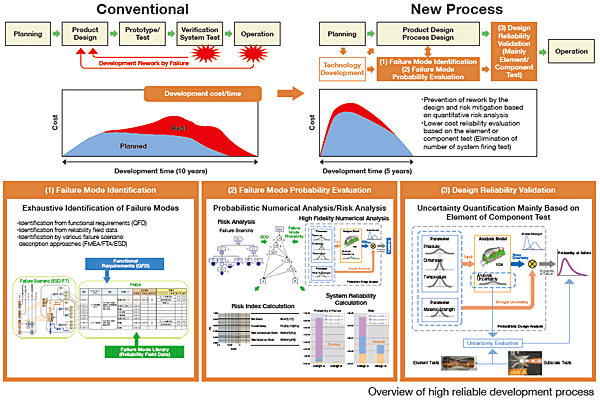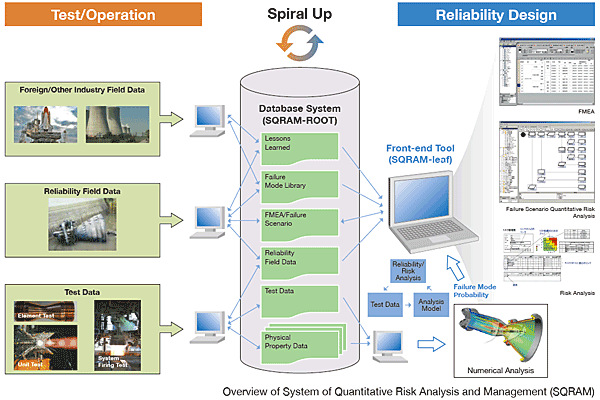Information Systems for Space Transportation Projects
- Team for Information Systems of Space Transportations -

Toward the achievement of highest reliability and international competitiveness of space launch vehicles, JAXA is making comprehensive efforts to establish high-reliability development process which enables to reduce the cost and the duration of launch vehicle development. JEDI center is challenging the establishment of an innovative reliable development methodology by proactively using state-of-the-art information technology and system reliability engineering techniques.
Objectives of Team for Information Systems of Space Transportations
Establishment of highly reliable space transportation system development process
We will establish new development process of liquid rocket engine to achieve high-reliability in lower cost and shorter development time. To achieve this goal, JEDI’s high-fidelity simulation technology is utilized to the maximum extent possible.
We will develop information system to implement the new development process certainly.
We will apply new development process to next-generation launch vehicle development activity.
New Development Process for High-reliable Space Transportation System
In the development of space launch vehicles, design validation and system reliability evaluation has been carried
out based on the conventional test-fail-fix development process. Especially in the rocket engine development, a large
amount of expensive firing tests has been required. However, this process has two major drawbacks if it will be applied to
human-rated rocket engine development. First, it will be required a unrealistic amount of expensive firing tests for the
system reliability evaluation. Second, failures in the later development phase will result in the additional costs and
schedule delays such as the redesign and its validation experiments. Accordingly, it is crucial to establish the new
front-loading type development method in order to ensure the higher-reliable rocket engine development.
We are currently working with next-generation booster rocket engine (LE-X) research team to establish the high reliable
development process as follows:
- In order to prevent development reworks, reliability design consideration should be done from the initial stage of development. Firstly, failure modes are identified comprehensively. For each failure modes, its probability is evaluated based on high-fidelity probabilistic numerical simulations. If needed, design is modified based on the simulation results to meet failure mode probability requirement.
- Engine system reliability is evaluated based on the numerical simulation models. Since these models can be validated based on element tests or/and component tests mainly, number of the expensive firing tests can be reduced.
- Furthermore, quantitative risk analysis is performed continuously from the early development phase. Based on the risk analysis results, risk monitoring and its mitigation are planned. All failure modes are ranked based on the risk analysis, high risk failure mode is prioritized in the risk mitigation plan. Consequently based on this new development method, high reliability should be achieved in the shorter development time and lower cost.
Information System to Support High Reliable Development Process
System of Quantitative Risk Analysis and Management (SQRAM)
In the new high reliable development method is highly depending on the quantitative risk analysis and various probabilistic numerical analysis for each failure mode. Since space launch vehicle consists of numerous subsystems and components, there are many contractors to develop each elements. This results in the complicated data handling including failure scenario, reliability field data and input data for numerical analysis.
In order to prevent incorrect data exchange and improve efficiency, development of information system, System of Quantitative Risk Analysis and Management (SQRAM), is in progress at JEDI.
SQRAM consists of two parts.
One is front-end tool (SQRAM-leaf) and the other is database system (SQRAM-ROOT).
In the new development method, failure scenario is exhaustively described based on the FMEA (Failure Mode and Effect Analysis) and FTA/ESD (Failure Tree Analysis/ Event Sequence Diagram). Based on the described failure scenario model, quantitative risk analysis is performed by Boolean logic calculation.
By using SQRAM-leaf, failure scenario can be described FMEA, FTA and ESD, minimal cut set/risk index can be calculated, reliability allocation and system reliability calculation can be performed.
Quantitative risk analysis is performed in all development stages. And it is essential to provide valuable heritage knowledge and technical data for the correct design decision. In addition, quality assurance of input data for the numerical analysis is also important for the success of new development method. In order to solve these problems, SQRAM-ROOT provide the platform to support complicated quantitative risk analysis.
SQRAM-leaf and ROOT can communicate to exchange the data such as analyzed failure mode probability.



